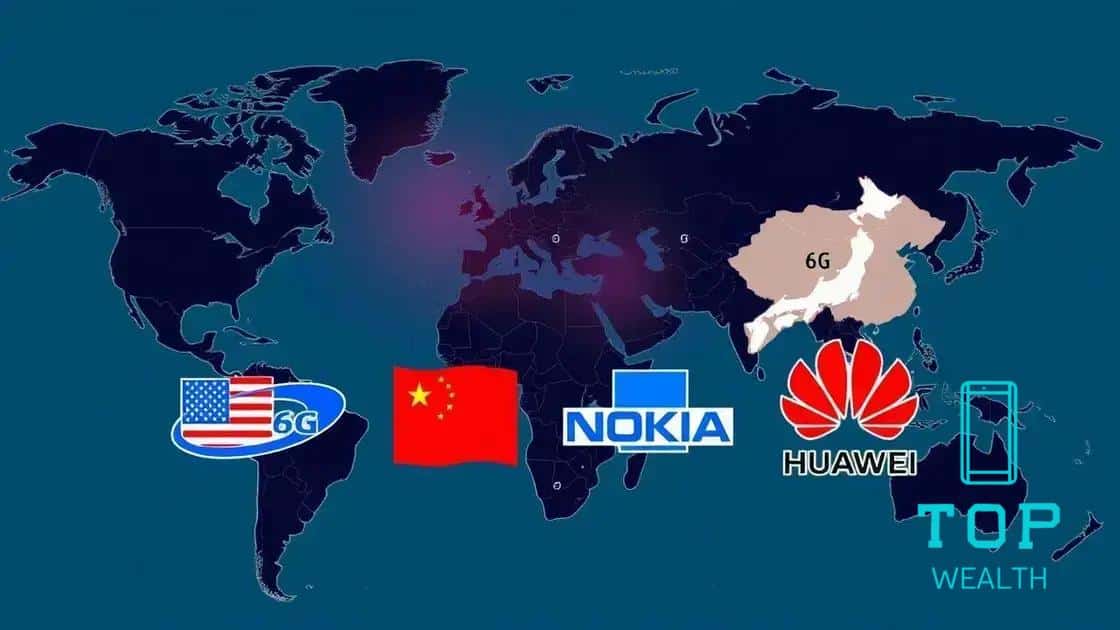Global race heats up for 6G deployment

The global race heats up for 6G deployment as this next-generation technology promises enhanced connectivity, faster data rates, and transformative applications across various sectors including healthcare, smart cities, and economic growth.
The global race heats up for 6G deployment as countries and companies vie for leadership in next-generation connectivity. Have you ever wondered how this will reshape our digital landscape?
Understanding the significance of 6G technology
Understanding the significance of 6G technology is crucial as we step into a future driven by advanced connectivity. This technology promises enhancements beyond what we currently experience with 5G, potentially revolutionizing numerous sectors.
What Makes 6G Unique?
6G is not just an upgrade; it represents a paradigm shift in how we connect and communicate. This technology is expected to enable high-speed data rates, lower latency, and connect a vast number of devices seamlessly. Imagine smart cities operating with interconnected systems relying entirely on 6G.
Key Benefits of 6G
- Extreme data speeds, potentially up to 1 Tbps.
- Improved reliability and lower latency for real-time applications.
- Support for advanced technologies like holographic communication.
- Greater connectivity for IoT devices, enhancing smart environments.
The importance of 6G technology extends to various industries. From healthcare to education, the impact of faster and more reliable networks can facilitate innovations we have yet to imagine. For instance, telemedicine could evolve to provide real-time holographic consultations, transforming patient care.
In addition, enhanced virtual reality (VR) and augmented reality (AR) experiences will likely become commonplace in entertainment and education, thanks to the capabilities of 6G. As we navigate this evolving landscape, staying informed about the significance of 6G technology becomes essential for leveraging its full potential.
Overall, the future is bright as we begin to understand the far-reaching implications of 6G technology. Its ability to connect, empower, and transform industries highlights its pivotal role in shaping our digital future.
Key players in the global 6G race

Key players in the global 6G race are emerging as countries and companies invest heavily in next-generation technologies. Understanding who these leaders are can shed light on the future of connectivity.
Countries Leading the Charge
Nations like the United States, China, and Japan are at the forefront of 6G development. Each country has outlined strategic plans to accelerate research and deployment.
- United States: With its robust tech industry, the U.S. focuses on innovations in artificial intelligence and Internet of Things (IoT).
- China: Home to major telecom giants, China is heavily investing in 6G technologies and aims for global leadership.
- Japan: Known for its advanced technology, Japan is exploring 6G applications in various sectors.
These countries understand that 6G technology will not only boost their economies but also enhance their global influence. Collaborations between governments and private sectors are common, creating a strong ecosystem for innovation.
Leading Tech Companies
Tech giants like Samsung, Nokia, and Huawei are also significant players in the 6G competitive landscape. Their contributions in research and technology development play a vital role in shaping the future of this technology.
- Samsung: This South Korean company is leading research in 6G networks, focusing on ultra-high-speed connectivity.
- Nokia: Nokia is collaborating with various partners to develop 6G standards and applications.
- Huawei: Despite challenges, Huawei continues to invest in 6G research and development, aspiring to be a market leader.
As these key players continue their efforts, the global landscape of 6G technology will undoubtedly evolve. The race is not just about speed; it involves shaping policies and standards that will define this new era of connectivity.
Challenges facing 6G deployment
The challenges facing 6G deployment are numerous and complex. As industries and countries rush to harness the potential of next-generation connectivity, several obstacles stand in the way.
Technical Challenges
One of the primary hurdles is the technical complexities inherent in developing 6G technology. The jump from 5G to 6G involves significant advancements in hardware and software.
- Network Infrastructure: Upgrading the existing infrastructure is necessary, which requires substantial investment.
- Integration with Current Technologies: Ensuring compatibility with 5G and other technologies can complicate rollout efforts.
- Latency Requirements: Achieving the ultra-low latency needed for applications like remote surgeries poses significant engineering challenges.
Alongside technical issues, regulatory concerns also obstruct progress. As new technologies emerge, governments must create comprehensive policies that govern their use.
Regulatory and Policy Dilemmas
Countries often have differing regulations that affect how 6G deployment can proceed.
- Spectrum Allocation: The allocation of frequency bands is critical, and competition between countries can delay progress.
- Data Privacy Regulations: As connectivity increases, so do concerns about data security and privacy, requiring robust regulations.
- International Collaboration: Global cooperation is essential, but political tensions can hinder collaborative efforts.
As the race heats up, industry leaders are also facing market demands. The need for 6G technology to provide tangible benefits to consumers is pressing, and this necessitates rapid innovation.
Ultimately, addressing these challenges requires not just technological innovation but also collaborative efforts among governments, companies, and researchers. Only through overcoming these hurdles can the promise of 6G technology be fully realized.
Potential applications of 6G

The potential applications of 6G technology are exciting and vast. As we look toward the future, it’s clear that this technology will transform various industries and enhance daily life.
Healthcare Innovations
One of the key areas benefiting from 6G is healthcare. With ultra-reliable low latency communication, doctors will be able to perform procedures through robotics with real-time feedback.
- Remote Surgery: Surgeons can operate on patients from thousands of miles away.
- Wearable Devices: Patients can be monitored continuously, allowing for immediate adjustments in treatment.
- Telemedicine: Virtual consultations will become more efficient and effective, improving access to healthcare.
In addition to healthcare, the education sector will see significant advancements. 6G technology will support immersive virtual classrooms and interactive learning experiences.
Smart Cities and IoT
Another promising application lies in the development of smart cities, where interconnected devices work seamlessly. This will lead to enhanced public services and sustainability.
- Traffic Management: Real-time data will be used to reduce congestion and improve traffic flow.
- Energy Efficiency: Smart grids will optimize energy use by adjusting to real-time demand.
- Public Safety: Enhanced surveillance systems will improve crime response time and emergency services.
The possibilities continue with augmented reality (AR) and virtual reality (VR) technologies. With the speed of 6G, experiences will become more immersive, allowing users to engage in realistic simulations.
In entertainment, streaming services will provide high-definition content with reduced buffering times, making for a smoother viewing experience.
Moreover, autonomous vehicles will benefit greatly from the rapid data transfer speeds of 6G. They will communicate with each other and their environment in real time, making transportation safer and more efficient.
Future implications of 6G on global connectivity
The future implications of 6G technology on global connectivity are vast and transformative. As we move towards an increasingly interconnected world, the impact of 6G will shape how we communicate, work, and live.
Enhanced Global Communication
One of the most significant effects of 6G will be the enhancement of global communication. The technology’s expected data rates and lower latency will make real-time interactions across borders seamless.
- Instant Communication: People will communicate with minimal delays, making virtual meetings feel more natural.
- Breakthroughs in Collaboration: International teams can work together without the disruptions typically caused by network lag.
- Accessibility: Remote areas will gain improved access to communication resources, bridging the digital divide.
As connectivity improves, the economic implications also become crucial. Countries and businesses will benefit from enhanced digital infrastructure that supports various sectors.
Impact on Economic Growth
With the capabilities of 6G technology, economies can experience accelerated growth through greater productivity and efficiency.
- New Business Models: Innovative startups can emerge, leveraging 6G for IoT and AI applications.
- Job Creation: The expansion of 6G infrastructure will create numerous job opportunities in technology and engineering.
- Global Trade: Improved logistics solutions can enhance international trade by streamlining supply chains.
Moreover, 6G technology will contribute to sustainability efforts worldwide. The ability to collect and analyze data in real time can lead to better resource management.
Sustainable Development
This technology will empower initiatives targeting energy efficiency and environmental protection. Cities can utilize real-time data to optimize energy use, reducing overall consumption.
Furthermore, smart agriculture will benefit from 6G by enabling farmers to monitor conditions instantly and apply precise interventions. The implications for food security and environmental stewardship are profound.
As we look ahead to the future with 6G technology, its influence on global connectivity will redefine how we interact and collaborate. The combination of enhanced communication, economic growth, and sustainability will foster a new era of global connectivity.
FAQ – Frequently Asked Questions about 6G Technology and Global Connectivity
What is 6G technology and how is it different from 5G?
6G technology is the next generation of mobile connectivity that promises higher data rates, lower latency, and improved network reliability compared to 5G.
What are the potential applications of 6G?
Potential applications include enhanced telemedicine, smart cities, autonomous vehicles, and immersive virtual and augmented reality experiences.
How will 6G impact global economic growth?
6G is expected to drive economic growth by enabling new business models, increasing productivity, and creating job opportunities in various sectors.
What challenges does 6G deployment face?
Challenges include technical complexities, regulatory hurdles, and the need for significant investment in infrastructure.





